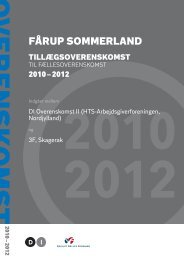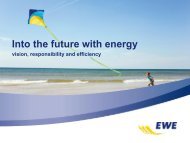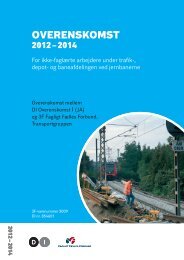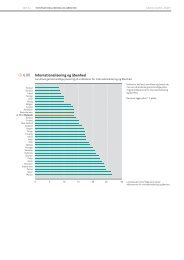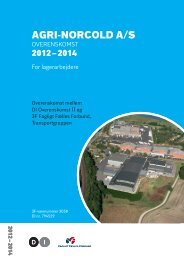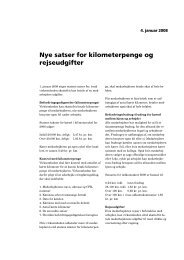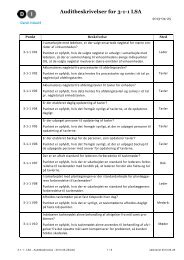Hydrogen and its competitors, 2004
Hydrogen and its competitors, 2004
Hydrogen and its competitors, 2004
You also want an ePaper? Increase the reach of your titles
YUMPU automatically turns print PDFs into web optimized ePapers that Google loves.
12Risø Energy Report 3<strong>Hydrogen</strong> in European <strong>and</strong> global energy systems3viable fuel for vehicles. The four-year project will use afleet of cars to test a hydrogen infrastructure, includinghydrogen production <strong>and</strong> storage, filling stations, fuelcells <strong>and</strong> internal combustion engines running onhydrogen.Munich Airport hydrogen service station (ARGEMUC H2)is also concerned with the daily use of hydrogen as atransport fuel. The project began in 1999 <strong>and</strong> is demonstratinghydrogen refuelling facilities for buses, cars <strong>and</strong>a fork lift truck.CUTE, a project co-funded by the European Commissionbut with highly active German partners. The objective isto demonstrate hydrogen production, storage <strong>and</strong> use infuel cells. Nine European cities are involved in buildingtest facilities, including production (steam reforming<strong>and</strong> electrolysis), hydrogen filling stations <strong>and</strong> busespowered by fuel cells.JapanJapan has for a number of years been one of the mostambitious countries in developing hydrogen energytechnologies <strong>and</strong> strategies. In 2002 the JapaneseMinistry of Economy, Trade <strong>and</strong> Industry (METI)launched a comprehensive programme aiming at fullcommercialisation of fuel cells <strong>and</strong> a hydrogen infrastructureby 2020. The total budget is approximately $4billion, with $250 million set aside for the first five years.The programme has three phases. The demonstrationphase focuses on developing technology, demonstratingmobile <strong>and</strong> stationary fuel cells <strong>and</strong> establishing codes<strong>and</strong> st<strong>and</strong>ards. The introductory phase, which will lastfrom 2002 to 2010, concentrates on research <strong>and</strong>demonstration. By 2010, 50,000 fuel cell vehicles <strong>and</strong> 2.1GW of stationary fuel cells are expected to be in operation.The “diffusion” phase, which will run from 2010 to2020, will concentrate on the wide implementation ofhydrogen technology. By 2020, Japan expects to have5,000,000 fuel cell vehicles, 4,000 hydrogen fillingstations <strong>and</strong> 10 GW of stationary fuel cell cogenerationplants.This ambitious programme is the latest part of an intensivehydrogen R&D effort that began in the early 1980s.The result is that Japan is a world leader in hydrogentechnology, especially in commercialisation as opposedto basic research. The work has largely been co-ordinatedby the government – METI <strong>and</strong> NEDO (New Energy <strong>and</strong>Industrial Technology Development Organisation) – buthas also been driven by car manufacturers <strong>and</strong> otherindustries. This public-private partnership makes theJapanese hydrogen programme extremely efficient,because everybody is pulling in the same direction.Though Japan is developing a broad range of hydrogentechnologies, most of the work is on developing, demonstrating<strong>and</strong> implementing fuel cells. Japaneseresearchers are working on all four of the main types offuel cells: phosphoric acid fuel cells (PAFCs), moltencarbon fuel cells (MCFCs), solid oxide fuel cells (SOFCs)<strong>and</strong> proton exchange membrane fuel cells (PEMFCs).This year Japan will become the first country in theworld to begin mass-producing fuel cell vehicles, with 50or more vehicles planned.Japan's comprehensive commercialisation strategy forhydrogen is made up of a number of individualprogrammes. Some of the most important of these are 4 :The New <strong>Hydrogen</strong> Project. This project is a continuationof WE-NET (International Energy Network Using<strong>Hydrogen</strong> Conversion), which began in 1992. The mainobjective of the programme is to develop safety technologiesfor fuel cell vehicles <strong>and</strong> hydrogen fillingstations, but R&D on hydrogen production <strong>and</strong> storageis also carried out.Japan <strong>Hydrogen</strong> <strong>and</strong> Fuel Cell Demonstration Project. Thisproject aims to demonstrate fuel cell vehicles <strong>and</strong>hydrogen filling stations. Ten hydrogen filling stationsusing various energy sources (gasoline, naphtha,methanol, kerosene, natural gas, LPG) <strong>and</strong> technologies(reforming, electrolysis, liquid storage, high-pressure gasstorage, recovery of waste hydrogen from industrialprocesses) will be tested in seven fuel cell vehicles <strong>and</strong>one fuel cell bus. Both Japanese <strong>and</strong> foreign car manufacturersare participating.Development of regulations, codes <strong>and</strong> st<strong>and</strong>ards forhydrogen vehicles <strong>and</strong> filling stations are in preparationfor the use of privately-owned hydrogen vehicles onJapanese roads.USAThe USA has recently launched a comprehensive strategyfor the development of hydrogen vehicles <strong>and</strong> hydrogeninfrastructure. Over the next five years the Departmentof Energy (DOE) will spend approximately $1.5 billionon hydrogen R&D. The work will centre on developingfuel cells for automotive <strong>and</strong> stationary purposes, butwill also cover hydrogen production, storage <strong>and</strong> infrastructureas set out in the recent National <strong>Hydrogen</strong>Energy Roadmap. Basic research issues important forrealization of a hydrogen economy will also beaddressed.The programme will include research into three types offuel cells: PEMFCs, SOFCs <strong>and</strong> MCFCs. The production ofhydrogen from natural gas, clean coal, nuclear, biomass<strong>and</strong> other renewables will be investigated, as well ashydrogen storage, delivery technologies, sensors <strong>and</strong>control technologies. Another important task is todevelop codes <strong>and</strong> st<strong>and</strong>ards in readiness for the eventualcommercialisation of hydrogen technologies.Specific projects include: 5Solid State Energy Conversion Alliance (SECA), a partner-4. The hydrogen <strong>and</strong> fuel cell development in Japan is further described in [9].5. More information on the development of hydrogen in USA can be found in [13], [14] <strong>and</strong> [15].



